Country United States Type Security operations Size Field army | Branch United States Army Role Training support | |
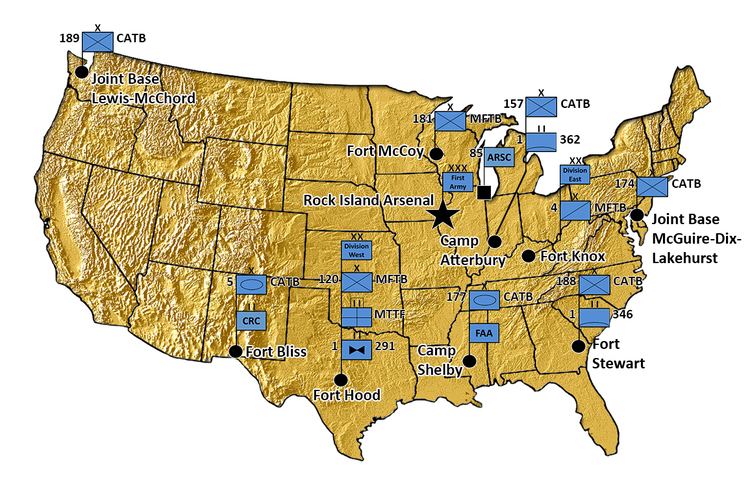 | ||
Active August 10, 1918 – April 20, 1919
September 8, 1932 – present | ||
The First Army is the oldest and longest established field army of the United States Army, having seen service in both World War I and World War II, under some of the most famous and distinguished officers of the U.S. Army. It now serves as a mobilization, readiness and training command.
Contents
- Establishment and World War I
- Inter war years
- World War II
- Post war and peacetime missions
- Shoulder sleeve insignia
- Insignia
- Lineage
- Campaign participation credit
- Decorations
- Current
- References

Establishment and World War I
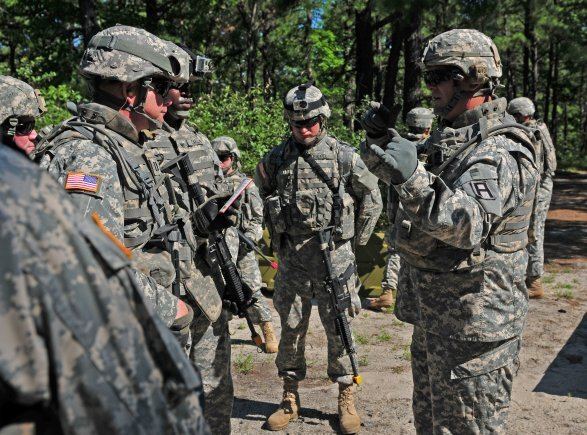
First Army was established on 10 August 1918 as a field army when sufficient American military manpower had arrived in France during World War I. As an element of the American Expeditionary Forces (AEF) in the latter stages of World War I it was the first of three field armies established under the AEF. Serving in its ranks were many figures who later played important roles in World War II. First Army was inactivated in April 1919.
Inter-war years

As part of an army reorganization and final realization of the 1920 amendment to the National Defense Act of 1916, Army Chief of Staff, General Douglas MacArthur directed the establishment of four field armies that each commanded three corps areas that were geographically located. The field armies were established to provide organizational structure for large military organizations that might be mobilized in time of national need.

First Army was located in the northeast United States and was activated on 11 September 1933 at Fort Jay, Governors Island, New York. Initially activated as a paper army, it was commanded by General Dennis E. Nolan. Until 1942, First Army's commander was always the senior commander of one of its three corps areas. The First Corps Area was headquartered in Boston, Massachusetts, Second Corps Area was headquartered at Fort Jay, Governors Island, in New York, New York, and Third Corps Area was located at Fort Howard (Maryland) near Baltimore, Maryland. Since First Army was only a paper organization in its early days, its staff was the existing staff of the corps areas. The overall mission of the First Army was commanding and training regular army, army reserve and national guard units in the three corps areas.
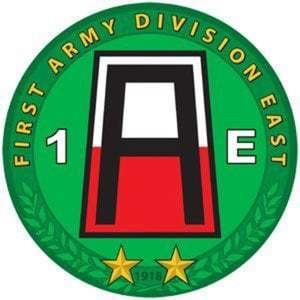
Nolan, the American Expeditionary Force's (AEF) chief of intelligence during World War I was followed by Major General Fox Conner, First Corps Area commander and another AEF veteran and its Chief of Operations. In the years after World War I, Conner was a crucial mentor in the careers of Dwight Eisenhower and George C. Marshall. Passed over as a candidate for Army Chief of Staff for Douglas MacArthur, Conner retired.
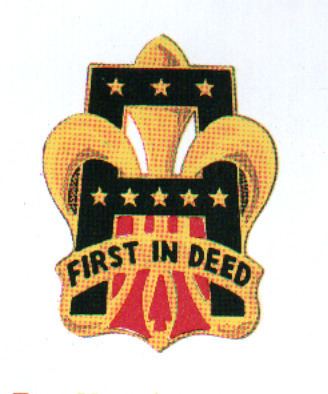
In 1938 First Army came under command of General Hugh A. Drum. Drum who along with a buildup of the Army in 1939 and through the early 1940s began to develop First Army into a bona fide field army. It began to establish and develop its own staff and participated in the large scale Army maneuvers in Louisiana and North Carolina between 1939 and 1941. As the United States entered World War II, Drum was assigned a new command of the newly established Eastern Defense Command, responsible for coastal and domestic defense. Drum retired in 1943 when he reached mandatory retirement age. General George Grunert, commander of Second Service Command assumed command of First Army until Headquarters, First Army was activated in Bristol, England, in January 1944 under command of General Omar Bradley.
World War II
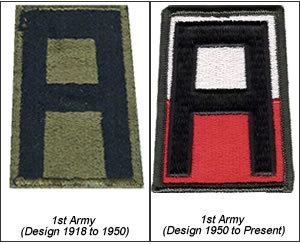
First Army's entry into World War II began in October 1943 as Bradley returned to Washington, D.C. to receive his command and began to assemble a staff and headquarters to prepare for Operation Overlord, the invasion of Normandy. Headquarters, First Army was activated In January 1944 at Bristol, England.
Upon going ashore on 6 June 1944, D-Day, First Army came under 21st Army Group and commanded all American ground forces during the invasion. Three American divisions were landed by sea at the Western end of the beaches, and two more were landed by air. On Utah Beach the assault troops made good time, but Omaha Beach came nearest of all of the five landing areas to disaster. The two American airborne divisions that landed were scattered all over the landscape, and caused considerable confusion amongst the German soldiers, as well as largely securing their objectives, albeit with units completely mixed up with each other. First Army captured much of the early gains of the Allied forces in Normandy. Once the beachheads were joined up, its troops struck west and isolated the Cotentin Peninsula, and then captured Cherbourg. When the American Mulberry harbour was wrecked by a storm, Cherbourg became even more vital.
After the capture of Cherbourg, First Army struck south. In Operation Cobra, its forces finally managed to break through the German lines. The newly established Third Army was then fed through the gap and raced across France. The Army then passed from the control of 21st Army Group to the newly arrived 12th Army Group. First Army followed Third Army and helped to surround the Falaise pocket.
After capturing Paris (the Wehrmachtbefehlshaber von Groß-Paris, Dietrich von Choltitz, capitulated 25 August, ignoring Hitler's Trümmerfeldbefehl), First Army headed towards the south of the Netherlands.
When the Germans attacked during the Battle of the Bulge, First Army found itself on the north side of the salient, and thus isolated from 12th Army Group, its commanding authority. It was, therefore, transferred, along with Ninth Army, to British 21st Army Group under General Montgomery on 20 December. The salient was reduced by early February 1945. Following the Battle of the Bulge, the Rhineland Campaign began, and First Army was transferred back to 12th Army Group. In Operation Lumberjack, First Army closed up to the lower Rhine by 5 March, and the higher parts of the river five days later.
On 7 March, in a stroke of luck, Company A, 27th Armored Infantry Battalion (AIB), part of Combat Command B, found the Ludendorff Bridge across the Rhine at Remagen was still standing. It quickly captured the bridge and established a secure bridgehead. in the next 15 days over 25,000 troops and their equipment crossed the river. By 4 April, an enormous pocket had been created by First Army and Ninth Army, which contained the German Army Group B under Field Marshal Model, the last significant combat force in the north west of Germany. Whilst some elements of First Army concentrated upon reducing the Ruhr pocket, others headed further east, creating another pocket containing the German Eleventh Army. First Army reached the Elbe by 18 April. There the advance halted, as that was the agreed demarcation zone between the American and Soviet forces. First Army and Soviet forces met on 25 April.
In May 1945, advance elements of First Army headquarters had returned to New York City and were preparing to redeploy to the Pacific theater of the war to prepare for Operation Coronet, the planned second phase of Operation Downfall the proposed invasion of Honshū, the main island of Japan in the spring of 1946, but the Japanese surrender in August 1945 thanks to the atomic bombings of Hiroshima and Nagasaki terminated that effort.
Post-war and peacetime missions
First Army returned to the United States in late 1945; first to Fort Jackson (South Carolina), then to Fort Bragg, North Carolina, returning to Fort Jay, Governors Island, New York, in the spring of 1946. Twenty years later, in 1966, First Army relocated to Fort Meade, Maryland, and took over the responsibilities of Second Army, which was inactivated. In 1973, First Army's mission changed from training and preparation of active units to Army Reserve units. In a 1993 reorganization, five divisions carried out that training and support mission:
75th Division, Houston, Texas 78th "Lightning" Division, Edison, New Jersey 85th "Custer" Division, Arlington Heights, Illinois 87th "Golden Acorn" Division, Birmingham, Alabama 91st "Wild West" Division, Dublin, CaliforniaIn 1993, Headquarters First Army relocated to Fort Gillem, near Atlanta, Georgia, and became responsible for the training and mobilization of all Army Reserve and National Guard units in the United States and providing assistance to the civilian sector during national emergencies and natural disasters. In the latter role, First Army's contributions during the 2005 Hurricane Katrina disaster was a rare bright spot in leading federal relief efforts in the aftermath of the storm. Its commander, Russel L. Honoré, a Louisiana native, became a nationally recognized figure in his direct, no-nonsense approach to disaster relief which earned First Army a Joint Meritorious Unit Award.
In the 21st century, First Army was subjected to more changes as base closures and force structures were instituted to modernize, economize and change its mission. In 2005, a BRAC decision called for the relocation of First Army headquarters to Rock Island Arsenal, Illinois, in 2011. Its former quarters at Fort Gillem was to transition to a single national location for the mobilization and demobilization of Army National Guard and Reserve units.
In a second change, as part of the 2006 reorganization of the United States Army program, First Army exchanged its civilian assistance mission for the training and support missions for military units in the western United States formerly held by US Fifth Army. Fifth Army then became U.S. Army, North with responsibilities for homeland defense and domestic emergency assistance.
First Army deactivated its training divisions, this is known as standing down. The units were reactivated as separate training brigades under two commands. First Army Division East, headquartered at Fort George G. Meade, Maryland, has responsibilities in all states east of the Mississippi River; and First Army Division West assuming Fifth Army's role and relocating from Fort Carson to its new headquarters at Fort Hood, Texas, oversees units in all states west of the Mississippi River.
First United States Army was redesignated as First Army on 3 October 2006.
Shoulder sleeve insignia
- The red and white of the background are the colors used in flags for Armies.
- The letter "A" represents "Army" and is also the first letter of the alphabet suggesting "First Army."
- A black letter "A" was approved as the authorized insignia by the Commanding General, American Expedition Force, on 16 November 1918 and approved by the War Department on 5 May 1922.
- The background was added on 17 November 1950.
Insignia
- A gold color metal and enamel device 1¼ inches high overall consisting of a black enamel capital letter "A" bearing three gold stars on the top cross bar and five gold on the center cross bar, in front of and interlaced with a gold fleur-de-lis.
- The vertical petal is charged in base with a red enamel arrowhead behind and extending above the letter "A" and the tops of the two outside or flanking petals above the cross bar extending over the vertical legs of the letter "A".
- The lower ends of the outside petals curve under and over the lower ends of the vertical legs of the letter "A" and are joined together by a gold arched scroll inscribed "First In Deed" in black enamel letters.
- The areas within the letter "A" above the center cross bar are white enamel and the areas below the cross bar are red enamel.
- The basic design was suggested by the authorized shoulder sleeve insignia of the First Army.
- The Interlaced fleur-de-lis represent wartime service in France and alludes to the initial organization of the Headquarters Company as the Headquarters Troop, First Army at La Ferte-sous-Jouarre, France 10 August 1918.
- The three stars at the top of the letter "A" are for Lorraine 1918, St. Mihiel and Meuse-Argonne campaigns in which the First Army participated in World War I.
- The five stars on the center cross bar are for the Normandy, Northern France, Rhineland, Ardennes-Alsace and Central Europe campaigns in which the First Army participated in World War II, the red arrowhead referring to the assault landing on the Normandy beaches.
- The motto "First In Deed" is based on the numerical designation, purpose and achievements of the First United States Army.
Lineage
Campaign participation credit
- St. Mihiel
- Meuse-Argonne
- Lorraine 1918
- Normandy (with arrowhead)
- Northern France
- Battle of the Bulge
- Rhineland
- Ardennes-Alsace
- Central Europe
Decorations
Current
First Army Division East – Fort Knox, Kentucky
First Army Division West – Fort Hood, Texas
